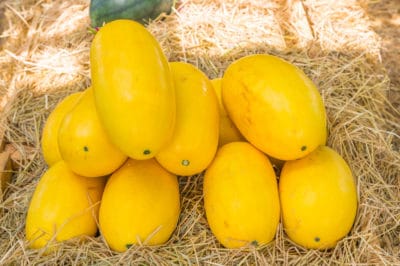How to Pick Spaghetti Squash
Unlike other winter squash varieties like butternut and acorn squash, spaghetti squash does not continue to ripen once you pick it. For this reason, making sure it is entirely ripe before harvesting it is essential. Not only does immature spaghetti squash taste bland, but it also spoils rapidly. If you plan on storing the squash, obviously this is a problem.
To be sure the spaghetti squash is fully mature, look for the following signs:
- Vines that seem brown and nearly dead despite regular watering.
- Stems that are silvery-gray and feel dry to the touch.
- Rinds that are a bright yellow or golden color.
- Rinds that are too tough to scratch with a fingernail.
Tip: Most spaghetti squash are a bright yellow or golden when ripe. However, some varieties may mature with a different color. Check your seed packet to be sure what the final color should be.
Preparing Spaghetti Squash for Storage
Once you have harvested your spaghetti squash, you have to get it ready for long-term storage. Start by dusting off any dirt or debris that cling to the fruits.
Then, wash each squash carefully with an antibacterial soap or a weak bleach and water solution. Cleaning the squash this way will kill any bacteria that might be on the rind. It will also help prevent new bacteria from growing.
Tip: Some people prefer to use vinegar as a more organic way to wash the squash. Although this will work, the squash will not store as long so inspect them regularly for signs of spoilage.
Storing the Squash in a Root Cellar
The most prevalent method of storing winter squash is by using a root cellar or a cold, dark basement. The combination of cool temperatures and no light helps the spaghetti squash stay fresh for several months.
The ideal temperature for storing spaghetti squash is between 50-55°F (10-13°C). Additionally, there should be adequate airflow and minimal lighting. Do not stack squash on top of each other, and do not lay the squash directly on the floor. Instead, place the individual squashes on a layer of newspaper or shelves.
Tip: Despite the care you take, some squashes may still spoil in storage. You should check them weekly, looking for soft spots or cuts. If you find any, remove the squash immediately to prevent the rot from spreading through the entire crop.
Freezing Spaghetti Squash
If you have limited storage space or do not have access to a basement or root cellar in which to store your spaghetti squash, you can also freeze the squash. Although some winter squash like butternut or acorn squash can be stored uncooked, spaghetti squash has to be cooked before freezing.
However, it is a very simple process to cook the spaghetti squash. You can either steam or bake the squash, then pull the strands out of the shell with a fork. Let the squash cool completely, then place into a freezer bag. Let out as much air as possible, the store the bags flat in the freezer. Spaghetti squash will keep in the freezer for several months.
Tip: To reduce the moisture in the bags, leave the cooked spaghetti squash in a colander in the fridge overnight. Doing so allows the water to drain out and prevents the strands from becoming mushy.
Preparing Stored Spaghetti Squash
Whether you have stored the spaghetti squash in a root cellar or the freezer, the taste is just as good as if you picked it fresh. Either cook the raw squash or thaw out the frozen ones and use in your favorite recipe. You will be glad you took the time to store your crop correctly when you are eating it during the winter!
